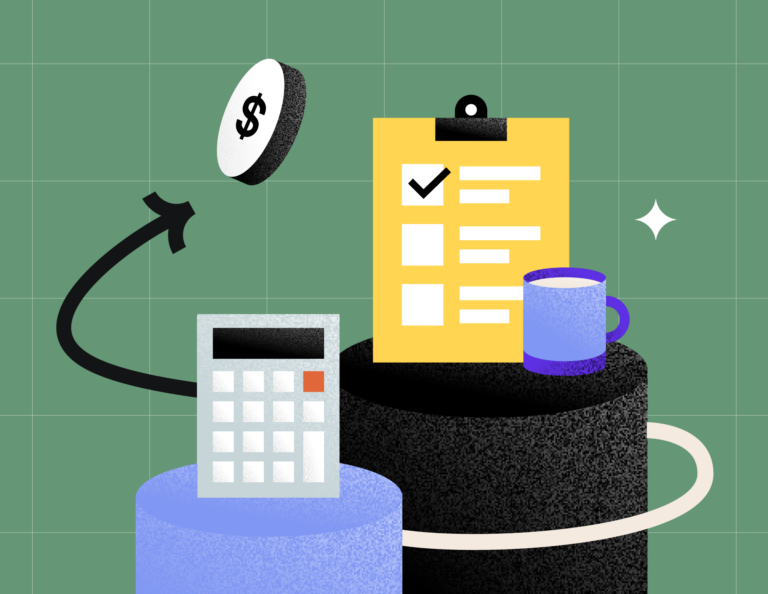To set a fair price, first, determine your total costs and how much clients expect to pay. Then, you can settle on a reasonable profit margin. Finally, you should determine a pricing model that attracts clients and supports your business.

Many independent businesses aren’t sure how to price a service. This is why a 2023 study found that charging too low of an hourly rate is the most common mistake for freelancers and independents at the beginning of their careers.
It can be especially difficult to price services if you offer custom services, like business consulting or photography. However, setting your prices just takes a bit of research and an understanding of common pricing models.
There are many factors in price calculation that you may not know to consider yet. Keep reading to learn the steps you should follow to price a service fairly.
Jump To:
- Figure out your costs
- Research your market
- Know your clients
- Consider your time investment
- Set a reasonable profit margin
- Choose a pricing model
- Other ways to set prices
- Simplify your prices for clients
1. Figure out your costs
You need to know your costs to figure out the bottom limit of your prices or your break-even point. Some of these are direct costs like materials and labor costs you need to account for. These are generally easy to identify because the purpose is primarily for the business. For a graphic designer, some of your costs will include software, labor, and equipment like a tablet or hard drive.
However, you also need to consider indirect costs. These are overhead costs that your business incurs but can’t pinpoint to a specific purpose, like rent, electricity, insurance, and marketing.
When you’re setting your prices, add up your costs to produce each project. Using a cost-plus pricing method, you can add a percentage to these costs and use that number to charge your clients. This method will ensure you’re generating a profit from each client. As you grow, you can continue to assess the added percentage to reach your desired profit margin.
2. Research your market
If your prices are too high, interested prospects will probably take their business to someone who charges less. As a result, you end up getting more clients if your prices are similar to competitors providing similar services. Conducting market research will help you figure out what people expect you to charge.

Pro Tip: You can also use your knowledge of competitors’ prices to set yourself apart. If you feel like you offer more value than your competitors — for instance, if you use better equipment than any other photographer in your area — you can charge more and communicate that value.
3. Know your clients
Knowing who your ideal clients are will help you set a price that aligns with what they’re willing to pay. Start with understanding demographic information such as:
- Income level – Income level can help give you a baseline for how much your clients would be willing to pay for your services.
- Family status – Married couples may be able to spend more on services than clients who are single, so this could be important to consider if you’re a photographer looking to price family photography versus solo portraits, for example.
- Job title – Income and family status will be better indicators of how much your clients are willing to pay, but job title can also provide more information.
- Regional location – Regional location will be easy to factor in if you only service a specific market. Take note of the cost of living there for additional insight into how you should price your services.
You can also distribute surveys to previous clients or set up focus groups to directly ask people in your target audience how they value your services.
4. Consider your time investment
As you spend more time in the industry, you build experience that brings more value to clients. Moreover, the time that you invested into your business generally saves your clients more time. Your prices should increase to reflect this higher value.
You should also consider the time you have to invest in each project. After all, if you spend longer on a project, you should earn more for it. Tracking the time you take to finish a project should help you figure out a fair price.
5. Set a reasonable profit margin
Now that you know your total costs and what people will generally pay for your services, you can think about your profit margin. Wider margins obviously make more money for the business but may discourage potential clients.
I recommend a profit margin between 10% and 20%, though your industry and market research should help you understand if that makes sense in your field.
6. Choose a pricing model
Now, you can create a pricing structure. The most common models are hourly pricing and per-project rates. Although, you can get more creative with your different services to entice clients and guarantee consistent income.
Some other pricing models you could try include:
- Subscription-based pricing: Clients can pay for your services monthly.
- Retainer: Clients buy a certain amount of hours or work for a preset and pre-billed fee.
- Tiered pricing: Your services are available in different price tiers, according to the volume of work, services you offer, or other adjustable factors.
Other ways to set prices
The process of setting a price yourself can be long and unappealing if you want to start working quickly. You may even just want to know a price that you can tell potential clients while you’re figuring out your pricing strategy.
In these cases, you could estimate a fair price by checking sites that hold price information on a large section of your industry. Here are some resources you could use.
Freelance websites
You can always check what other freelancers charge on a popular freelance platform, like Upwork. You can look at the profiles of a few people charging the most and a few charging the least for your industry category. Depending on how your skills and experience line up with theirs, you should be able to figure out a fair price point.
Pro tip: Freelancers on these sites often charge less than they should because they have to bid against each other for jobs. As a result, freelance websites are generally a good price-setting resource for people newer to the industry.
Salary estimate websites
Sites like Glassdoor collect salary data from thousands of professionals and freelancers. Because of the amount of data, these sites often give you an accurate picture of the current market.
So, if you just enter your job title and location, you can find a rough baseline for what you should charge. You can then adjust your number according to your skills and experience until it feels like you’re getting fair compensation.
Online tools
Many online tools tell you the rates that other people in your industry charge. They may also include filters so you can see how much people with your specific skills and experience level charge.
RELATED POST
Simplify your prices for your clients
Once you’ve priced your services, you need to communicate them simply and effectively to your clients. HoneyBook’s all-in-one clientflow platform can help you do that, letting you drop a services block into any file template that displays your pricing and packaging.
HoneyBook’s customizable templates let you incorporate your brand throughout, and you can explore different purposes for them. Send an individual pricing guide if you want to use a traditional file in your sales process. Or, you can add an online contract and online invoice to your pricing guide so clients can select services and pay in one step.
Streamline your sales and booking
Book more clients and grow your revenue by creating a seamless clientflow with HoneyBook.
See how it works



